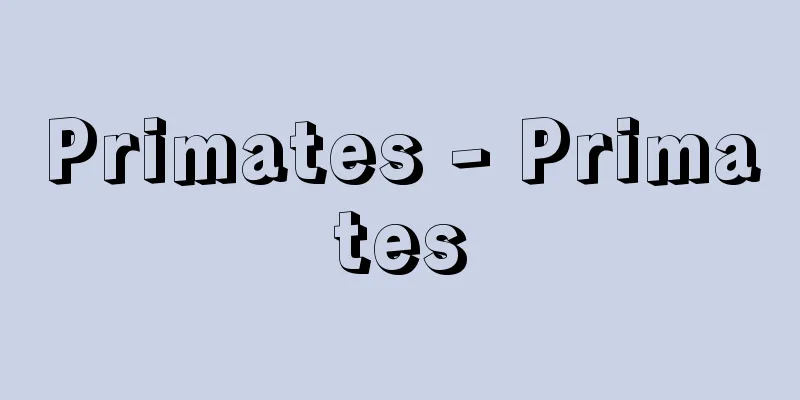Primates - Primates

|
Primates are the monkey family, including humans. All living things are divided into classes, from smaller to larger, namely species, genus, family, order, class, phylum, and kingdom. For example, humans are the species with the scientific name Homo sapiens, but to be precise, they belong to the kingdom Animalia, phylum Vertebrate, class Mammalia, order Primates, family Hominidae, genus Homo, and species Homo. [Classification and phylogeny] Living things are described by their scientific name. A scientific name is a universal name given to living things, and is written in Latin. The method of naming scientific names was invented by Linné, C. von, and is called binomial nomenclature. In other words, it is an expression that combines the name that represents the genus and the species, that is, the genus name and the specific epithet. For example, Homo sapiens is the scientific name for humans, which means the genus Homo sapiens species, or wise person. The scientific name is translated into Japanese as Homo genus Homo species. When referring to the "species name" of a given organism, it is a name described by binomial nomenclature (for example, Homo sapiens), so the term "specific epithet" refers only to the latter of the genus name (Homo) and the subsequent subclassification name (Sapiens). In other words, Sapiens is the specific epithet, and Homo sapiens is the species name. Scientific names are merely labels. They are labels that have been assigned over a historical process. Objects have been labeled and classified. Such classifications do not necessarily correspond to the evolutionary lineage of the organisms in question. Classification is a historical and arbitrary product of humans. In contrast, lineage refers to facts that actually occurred during the evolutionary process. Scientific endeavors attempt to discover true lineages through fossil and genome analysis. However, in order to do this, a label is needed to describe and identify the object in question, and this is the scientific name. The most important thing to understand about the term primate is that it does not mean primates or monkeys. The misunderstanding that "primates" = "apes" is widespread, and the incorrect juxtaposition of "humans and primates" is often seen. Primates are the monkey family, including humans. Since humans are included, the correct expression would be "humans and other primates." Similarly, the dichotomy between humans and animals is also not correct. Humans are a type of animal. Therefore, the correct expression would be "humans and other animals." [Mammals] Primates are a group within the higher classification of mammals (class Mammalia). It is said that there are currently about 5,000 species of mammals living on Earth. Of these, about 300 species are primates. Mammals other than primates include carnivores such as dogs, cats, and bears, even-toed ungulates such as cows, deer, hippos, and giraffes, odd-toed ungulates such as horses, tapirs, and rhinos, and rodents such as mice, squirrels, and porcupines. Rodents, accounting for about half of all mammal species, are the most numerous. About 65 million years ago, there was a global environmental change that caused the extinction of the dinosaurs that had flourished until then. In their place, the common ancestor of mammals adapted to various environments and radiated out. The common ancestor of mammals was a small, terrestrial, nocturnal animal, but primates became arboreal and diurnal. Mammals are called quadrupeds, and a distinctive feature of primates is that the ends of their limbs are hand-shaped and can grasp objects. Primates were once called tetrapods. Primates stand out from other mammals because they have four hands. There is a popular belief that in the evolution of humans, quadrupedal animals stood up, became bipedal, and then became able to use their hands to manipulate objects and use tools. This is not the case. Free hands are a characteristic of all primates that we inherited from our common ancestor. We grasped branches with our four hands and created a living niche in the trees. These are primates. Among primates, humans, in the course of their evolution, descended from the trees to the ground and began to walk on two legs in order to walk long distances. In other words, it is correct to understand that two legs developed from four hands. Imagine a non-human primate walking. They walk on all fours. However, when they stop, they do not stand on all fours like cows and horses. They sit with their hind legs folded and their torsos upright. It is the same as when we stand, lower our hips, and crouch deeply. This is because it is difficult to climb a tree if the torso is not upright. It is a popular myth that humans stood up from all fours and began walking upright on two legs during the course of their evolution. Primates have had hands and upright torsos from the beginning. The ability to hold the torso upright and freely grasp objects with the hands, a common feature of primates, led humans to develop feet in order to land on the ground and walk long distances. Human feet are a feature that other primates do not have. Primates became arboreal and diurnal. Therefore, unlike other mammals, they have color vision. They do not miss the change in color of ripe fruit. Also, in order to move through space from branch to branch, both eyes are positioned in front of the face, allowing them to detect depth. Binocular stereoscopic vision and color vision are characteristic of primates. Primates are found mainly in tropical and temperate zones. The Japanese macaque, which lives in the snow, is an exception and is the northernmost primate. As a result, there are no monkeys in North America or Europe. Japan is a rare developed country where non-human primates live. Since other monkeys also live in places where it is easy for humans to live, friction arises in coexistence. There is also the risk of damage to agricultural crops, known as "monkey pests," and the spread of zoonotic diseases. There is a need to establish measures for coexistence. [Primate societies] Some primates live alone, but most live in groups. When living in groups, if the children's generation remains in the group, inbreeding will occur. Therefore, as a measure to avoid this, children leave their original group. Logically, there are only three patterns. The first is that when they reach a certain age, the male leaves and the female remains in the group. It is a matriarchal society in which the grandmother-mother-daughter relationship remains. Most mammals, such as elephants, lions, and Japanese macaques, are matriarchal. In contrast, there are patriarchal societies in which the female leaves and the male remains in the group. Chimpanzees, gorillas, and spider monkeys are examples of this. The third path is a society in which both males and females leave when they reach a certain age. Gibbons are an example of this. It is a family in which male-female pairs give birth to and raise children. When they grow up, they leave that family and start a new family with a new mate. If we look at people who tell us about the lives of their ancestors, such as hunter-gatherers, humans are basically considered to be patriarchal societies like chimpanzees and gorillas. In other words, the common ancestor of the great apes that originated in Africa among primates became a patrilineal society, which was then passed on to humans, chimpanzees, and gorillas, and continues to exist today. The biggest difference between people in the 21st century and those in the 20th century is that we have a genomic view of humanity. All living things are made up of genetic information carried by a substance called DNA. In that respect, humans, chimpanzees, mice, E. coli, Arabidopsis, and rice are all the same. Attempts to decipher the genome (all genetic information), that is, to determine the sequence of the four bases, ATGC, that make up DNA, for each species of organism are rapidly progressing. The human genome was deciphered in 2003. Currently, complete genome analysis of other primates, such as chimpanzees and rhesus monkeys, has been completed. Furthermore, post-genome research is also being actively conducted. Specifically, focusing on genes, which are chains of DNA, detection of SNPs (single nucleotide polymorphisms), in which only one base has been changed, and the associated changes in phenotype are being investigated. It is also known that there is variation between individuals in the number of repeats (CNV) of DNA sequences. Research into the genetic background behind differences in behavior and personality is likely to become increasingly active in the future. [Human, Humanity, Human Being] Human refers to Homo sapiens (modern man) as a living organism, and is the only human species currently alive. Humanity is a general term for Homo sapiens and fossil humans who are already extinct. Fossil humans are a general term for extinct human species of which only fossils remain, such as ape-men such as Australopithecus, Homo erectus (early man), and Neanderthals (archaic man). Human being is a term used to include the cultural and social aspects of humans (Homo sapiens). In this dictionary, we use "hito" and "jinnen" appropriately in the above sense. When trying to understand humans, primates are unique from other animal groups in the sense that they are an animal group that includes humans. This is because the "we" that we know ourselves as are humans and primates. When trying to understand humans in the context of evolutionary history, research on primates is extremely important. → Great apes → Chimpanzees → Japanese macaques [Tetsuro Matsuzawa] Latest Sources Psychology Encyclopedia Latest Psychology Encyclopedia About Information |
|
霊長類とは,人間を含めたサルの仲間のことである。すべての生物は,より小さな分類から大きなものへと,種・属・科・目・綱・門・界という段階で分けられている。たとえば,人間は,学名がホモ・サピエンスという生物種だが,正確に全部をいうと,動物界,脊椎動物門,哺乳綱,霊長目,ヒト科,ヒト属,ヒト種である。 【分類と系統】 生物は,学名で記述する。学名とは,生物に付けられた世界共通の名称で,ラテン語を用いる。学名の命名法は,リンネLinné,C.vonが創案したもので,二名法とよばれる。つまり属と種を表わす名前,すなわち属名と種小名をつなげた表現である。たとえばホモ・サピエンスHomo sapiensが人間の学名で,ホモ属サピエンス種,知恵のある人という意味である。学名を和訳するとヒト属ヒト種である。なお当該の生物の「種名」といったときは,二名法によって記述される名前(たとえばホモ・サピエンス)なので,属名(ホモ)とそれに後続する下位分類名(サピエンス)のうち後者だけを指すことばとして「種小名」というよび方をする。つまり,サピエンスは種小名で,ホモ・サピエンスは種名である。 学名はあくまでラベルにすぎない。歴史的な経緯の中で付けられたラベルである。対象にラベルを付けて分類してきた。その分類と当該の生物の進化的な系統とは,必ずしも一致しない。分類は人間の歴史的かつ恣意的な産物である。それに対して,系統とは進化の過程で真に起こった事実のことを指す。科学的営為は,真の系統を,化石やゲノム解析から見つけようとしている。しかしそのためにも,当該の対象をひとまず記述し特定するラベルが必要であり,それが学名である。 霊長類という用語の理解で最もたいせつなのは,霊長類すなわちサルではない,ということである。「霊長類=サル類」という誤解が蔓延し,「人間と霊長類」という誤った対置表現をよく目にする。霊長類とは,人間を含めたサルの仲間のことである。人間も含まれているから,「人間とそれ以外の霊長類」というのが妥当な表現となる。同様に,人間と動物という二分法も妥当ではない。人間は動物の一種である。したがって「人間とそれ以外の動物」というのが妥当な表現となる。 【哺乳類Mammal】 霊長類は,より高次の分類でいえば,哺乳類(哺乳綱)の中の1グループである。現在この地球上にすむ哺乳類は約5000種いるといわれている。そのうちの約300種が霊長類である。霊長類以外の哺乳類は,イヌやネコやクマの類の食肉類,ウシやシカやカバやキリンの類の偶蹄類,ウマやバクやサイの類の奇蹄類,ネズミやリスやヤマアラシの類の齧歯類などがある。哺乳類の中で最も種数が多いのは,その約半数を占める齧歯類である。 約6500万年前に全地球規模の環境変動があり,それまで栄えていた恐竜が絶滅した。代わって哺乳類の共通祖先がさまざまな環境に適応し放散した。哺乳類の共通祖先は,地上性で夜行性の小動物だったが,霊長類は樹上性かつ昼行性になった。哺乳類は四足動物とよばれるが,霊長類の特徴は四肢の末端が手の形をしていて物を握れることである。霊長類はかつて四手類とよばれていた。手が四つあるということで,霊長類は他の哺乳類から際立っている。 人間の進化において,四足動物が立ち上がって二足になって両手が自由になり,その手で物を操って道具を使うようになった,という俗説がある。そうではない。すべての霊長類の特徴であり共通祖先から受け継いだものは,自由な手である。四つの手で枝をつかんで樹上に生活の場所ニッチnicheを構えた。それが霊長類である。霊長類の中で,人間はその進化の過程で,樹上から地上に降り立ち,長い距離を歩くために二足歩行をするようになった。つまり,四つの手から二つの足ができた,という理解が正しい。 人間以外の霊長類が歩く姿を想像してみよう。四足歩行する。しかし立ち止まったときには,ウシやウマのように四足にはならない。後肢を折りたたんで座り,体幹は直立している。われわれが立ったまま腰をぐっと下ろして,深くしゃがみ込んだ姿勢である。なぜなら,木に登るためには体幹は直立していないと登りにくい。人間はその進化の過程で,四足から立ち上がって直立二足歩行を始めた,というのは俗説である。霊長類は,最初から手があったし,体幹は直立していた。体幹を直立させて手で自由に物を握ることのできる霊長類共通の特徴から,人間は地上に降り立って長距離を歩くために足を生み出した。人間の足こそ,他の霊長類にはない特徴である。 霊長類は樹上性になるとともに昼行性になった。そのために,他の哺乳類と違って,色覚がある。熟れた果実の色の変化を見逃さない。また木の枝から枝へと空間を移動するために,両眼が顔の前面に位置して両眼で奥行きを検知できるようになった。両眼立体視と色覚は霊長類の特徴である。 霊長類は,主に熱帯と温帯に分布している。雪の中にすむニホンザルは例外的で,北限の霊長類である。したがって北米とヨーロッパにサル類はいない。日本は先進国の中で人間以外の霊長類がすむ稀有な国である。人間が暮らしやすい場所に他のサル類もすんでいるので共存にあたってはあつれきが生じる。猿害とよばれる農作物被害だったり,人獣共通感染症の恐れもある。共存する方策の確立が求められている。 【霊長類の社会】 単独生活をする霊長類もいるが,多くは群れを作って暮らしている。群れで暮らす場合,子どもたちの世代がそのまま群れに残ると近親交配になる。そこで,避ける方策として,子どもたちが出自の群れを出ていく。そのパターンは論理的にいって3通りしかない。第1は,年頃になると男性が出て女性が群れに残る。祖母-母-娘と残る母系社会だ。哺乳類の多くは,ゾウもライオンもニホンザルも母系社会である。それに対して女性が出て男性が群れに残る父系社会がある。チンパンジーやゴリラやクモザルがこれに当たる。第3の道は,男性も女性も年頃になると出ていく社会である。テナガザルがこれに当たる。男女のペアが子を産み育てる家族である。大きくなるとその家族から外へ出て,新たな配偶者と家族を作る。人間は,採集狩猟民など祖先の暮らしを伝える人びとを見ると,基本的にはおおむねチンパンジーやゴリラと同じ父系社会だと考えられる。つまり,霊長類の中で,アフリカに起源した類人猿の共通祖先が父系社会になった。それが人間,チンパンジー,ゴリラに受け継がれて今日に至ったと解釈できる。 21世紀のわれわれが20世紀の人びとと大きく異なるのは,ゲノム的人間観をもつことだろう。すべての生物が,DNAという物質が担う遺伝情報でできている。その点では,人間も,チンパンジーも,ネズミも,大腸菌も,シロイヌナズナも,イネも変わりはない。ゲノム(全遺伝情報)を解読する試み,すなわちDNAを構成するATGCという四つの塩基の配列を,各生物種で決める試みが急速に進んでいる。ヒトゲノムが2003年に解読された。現在では,他の霊長類でも,チンパンジーやアカゲザルの全ゲノム解析が終わっている。さらには,ポストゲノムの研究も盛んに行なわれつつある。具体的には,DNAの連鎖である遺伝子に着目し,1個の塩基だけ変化したSNP(スニップ,1塩基多型)の検出とそれに伴う表現型の変化が調べられている。また,DNAの配列の反復回数(CNV)にも個体間で変異のあることが知られている。行動や性格の違いが,どういう遺伝的背景のもとにあるか,そうした視点からの研究が今後ますます盛んになるであろう。 【ヒト・人類・人間】 ヒトとは,生物としてのホモ・サピエンス(新人)のことであり,現在生きている唯一の人類である。人類とは,ホモ・サピエンスとすでに死滅した化石人類の総称である。化石人類は,アウストラロピテクスなどの猿人,ホモ・エレクトゥス(原人),ネアンデルタール人(旧人)など死滅して化石しか残っいない人類の総称である。人間は,ヒト(ホモ・サピエンス)の文化的・社会的側面を含めてとらえる場合の用語である。本事典では,上記のような意味合いで「ヒト」と「人間」を適宜使い分けている。 人間を知ろうとするとき,人間を含めた動物群であるという意味で,霊長類は他の動物群とは違ってユニークな存在といえる。われわれ自身を知る,その「われわれ」が人間であり,霊長類だからである。人間を進化という歴史の中で理解するとき,霊長類の研究はきわめて重要だといえる。 →大型類人猿 →チンパンジー →ニホンザル 〔松沢 哲郎〕 出典 最新 心理学事典最新 心理学事典について 情報 |
Recommend
Prop
Russian (Soviet) folklorist. His 1928 work Morphol...
Dam (English spelling)
A dam is a dike-like structure built to prevent th...
Ascon - Ascon
...This refers to aggregates such as sand, gravel...
Namemiso - Namemiso
A general term for miso that is not used in miso s...
Alpheus rapax (English spelling) Alpheusrapax
… [Takeda Masatomo]. … *Some of the terminology t...
Kaguragamine
...The summit is flat, and the remains of the cra...
"The Strange Tale of the Martyrdom of Ebumina Nagasaki"
...Since the ban on Christianity in 1638 (Kan'...
Creosote - Creosote (English spelling)
It is a mixture of about 10 kinds of phenols, inc...
Aburauo - Oilfish
...A marine fish of the Perciformes family. Its m...
Servius Honoratus, Marius (Maurus)
A 4th-century Roman philologist and commentator, h...
Equus zebra (English spelling)
…[Yoshiharu Imaizumi]. … *Some of the terminology...
Course - Kaitei
〘 noun 〙 The scope of study or work that is assign...
Nachtigal, G. (English spelling) NachtigalG
...Other than that, all we know is that the Portu...
Imai Isshiken Sofu - Imai Isshiken Sofu
Dates of birth and death unknown. Artist of the e...
Usucha Temae - Usucha Temae
〘Noun〙 The manner of making thin tea in the tea ce...









